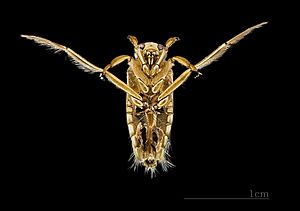Notonecta maculata facts for kids
Notonecta maculata is a fascinating insect often called a "backswimmer." It belongs to a family of insects known for swimming on their backs! You can find these interesting creatures in Europe, including places like the United Kingdom.
Quick facts for kids Notonecta maculata |
|
|---|---|
 |
|
| Notonecta maculata Ventral side | |
 |
|
| Notonecta maculata Dorsal side | |
| Scientific classification |
What Does It Look Like?
Notonecta maculata are small, light brown insects. They are part of a group called Hemiptera, which includes bugs like cicadas and aphids. These backswimmers have dark spots on their wings and body. They also have big, reddish eyes.
Their back legs are special! They are shaped like oars, just like the paddles you use in a boat. This helps them swim super fast in the water.
Adult Notonecta maculata can grow up to 2 centimeters long. That's about the size of a small paperclip! You can tell this species apart from other backswimmers by the cool, mottled, brick-colored patterns on their front wings.
What Do They Eat?
Notonecta maculata are very hungry hunters! They eat many small animals without backbones, called invertebrates, that live in their watery homes.
When they are young (called juvenile stages), they mostly eat tiny creatures like Daphnia magna and zooplankton. Zooplankton are tiny animals that float in the water. As they grow into adults, they also add mosquito eggs to their diet. They will pretty much eat anything they can catch!
Young Notonecta maculata choose their food based on size. If there are many sizes of Daphnia around, they will go for the biggest ones. Adult backswimmers also prefer larger Daphnia and zooplankton.
The amount of light affects how well young Notonecta maculata hunt. In the dark, they can only sense Daphnia when they are very close. So, they will grab the largest Daphnia they can find within that short distance.
Where Do They Live?
Notonecta maculata usually live in small freshwater ponds in the United Kingdom. But you can also find them in other places. They might live in storm water ponds, lakes, swamps, and rivers. As long as the water is fresh, they can make it their home.
Even though they can live in one pond their whole lives, they can also fly! If there are fish or other animals that might eat them, they will use their wings to fly to a different, safer pond.
Backswimmers, like the Notonecta genus, choose homes that help them hunt. They look for places with the right amount of plants, clear water, and plenty of food. Young Notonecta maculata (called instars) do best in simple environments. They might not survive as well in places with lots of complex plants or hiding spots. However, as they get older, they get better at surviving in these trickier places.
See also
 In Spanish: Notonecta maculata para niños
In Spanish: Notonecta maculata para niños

